

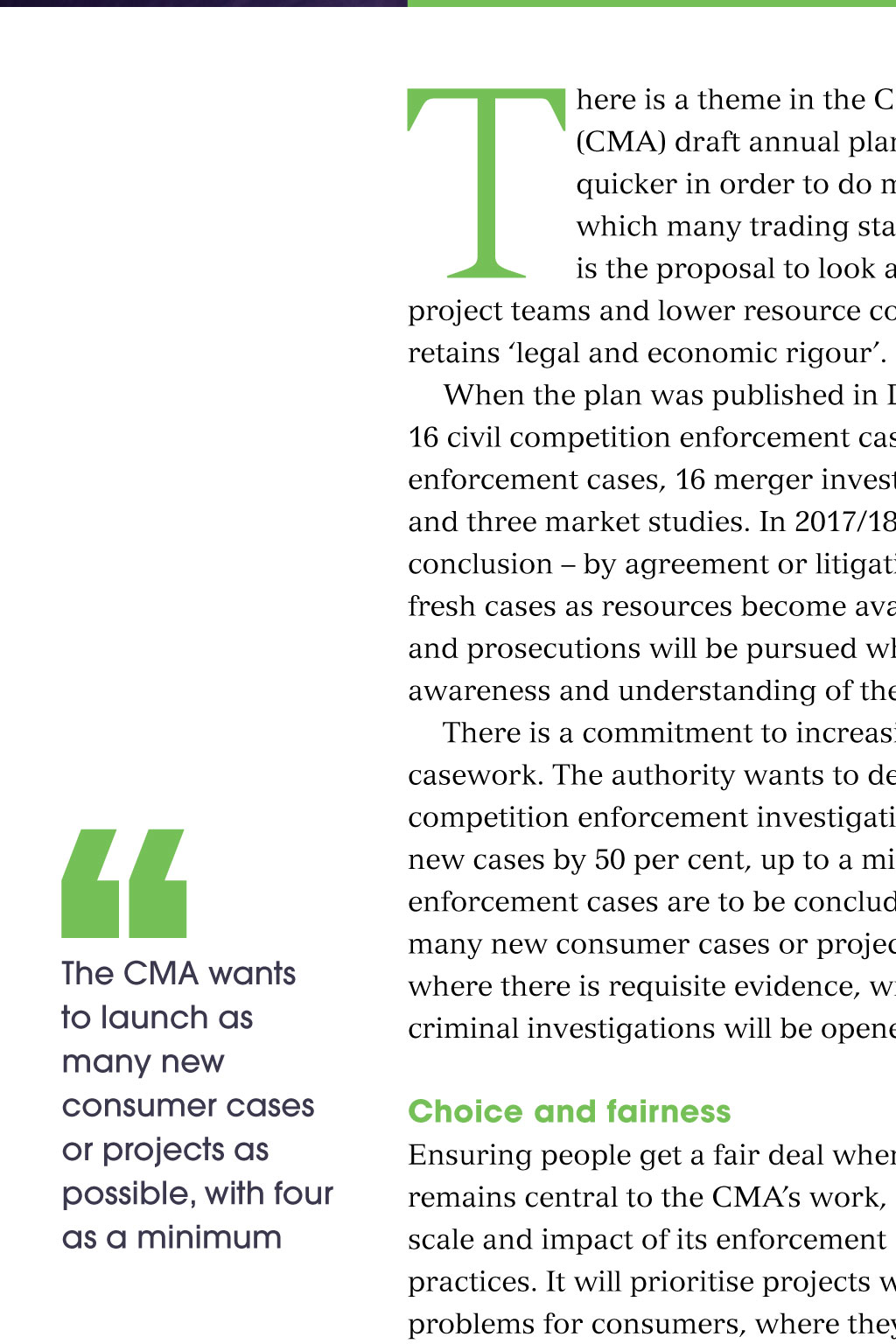
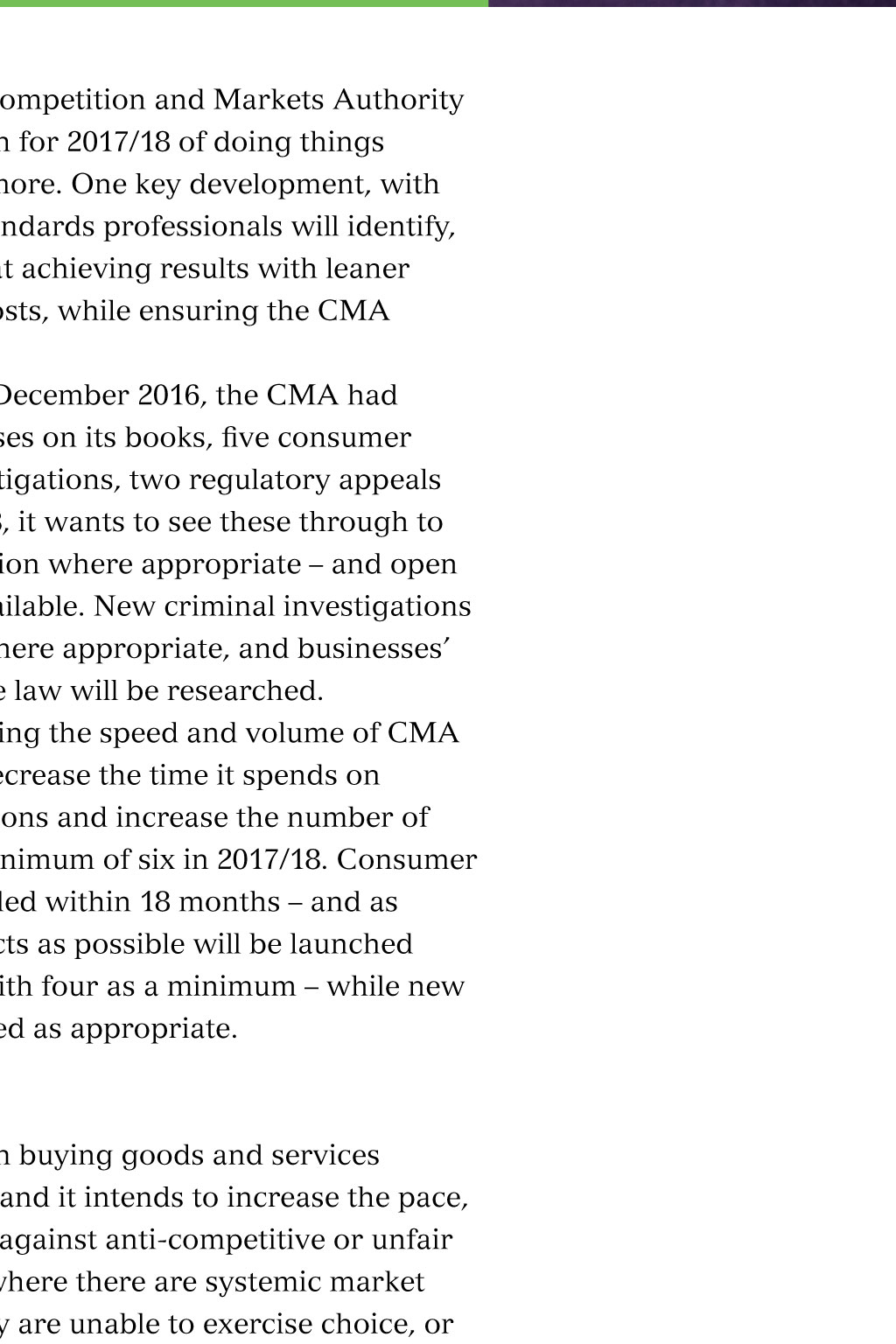
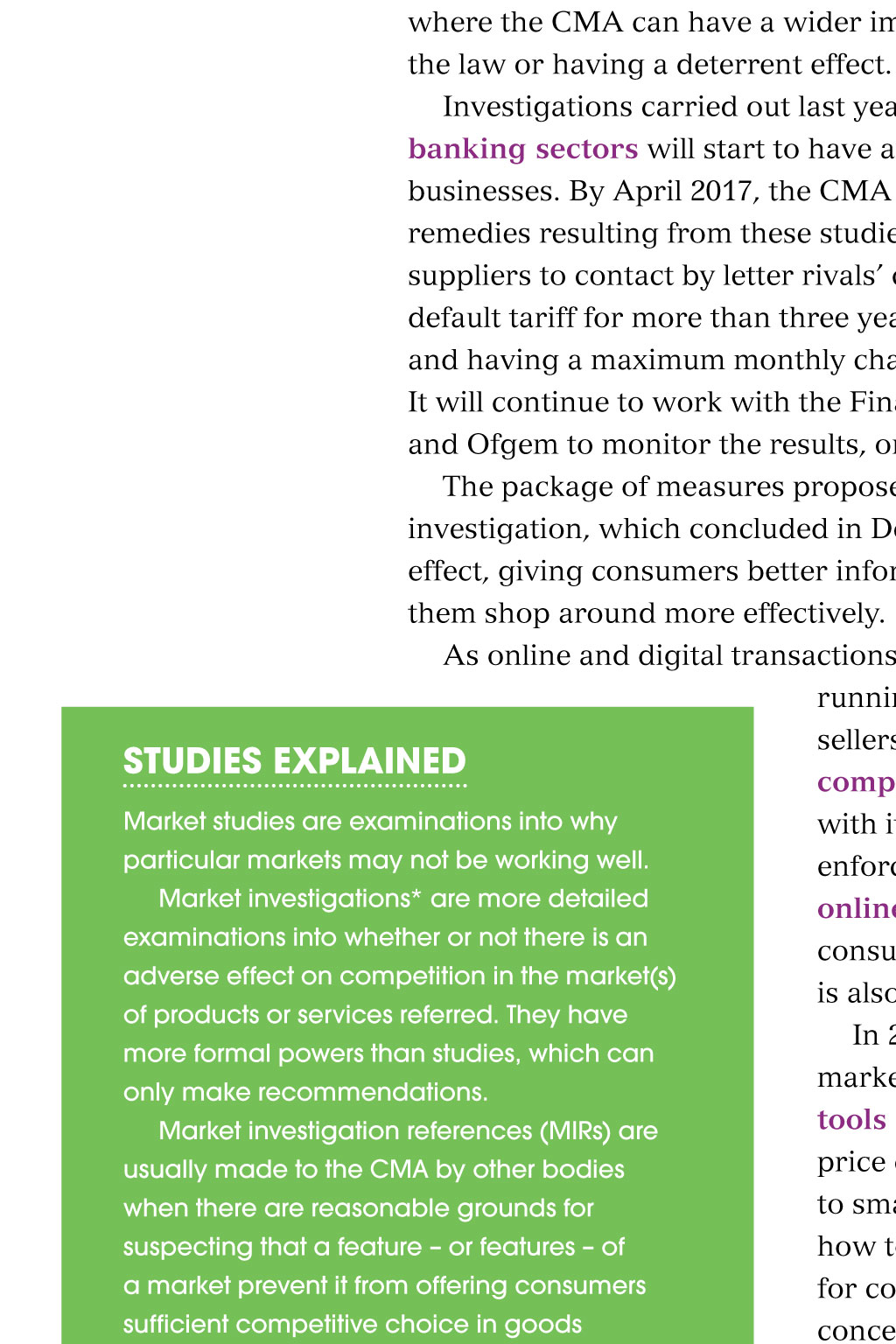
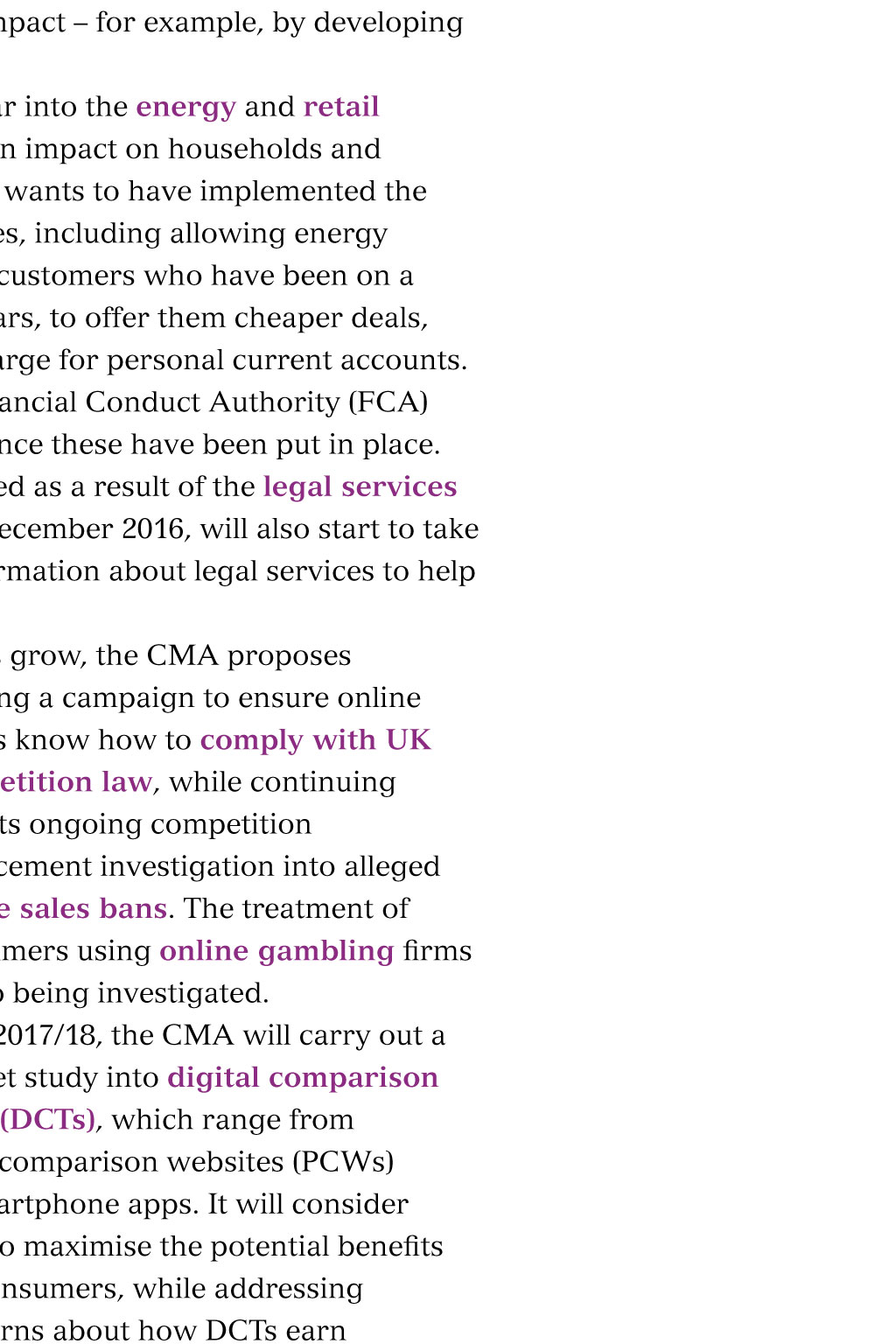
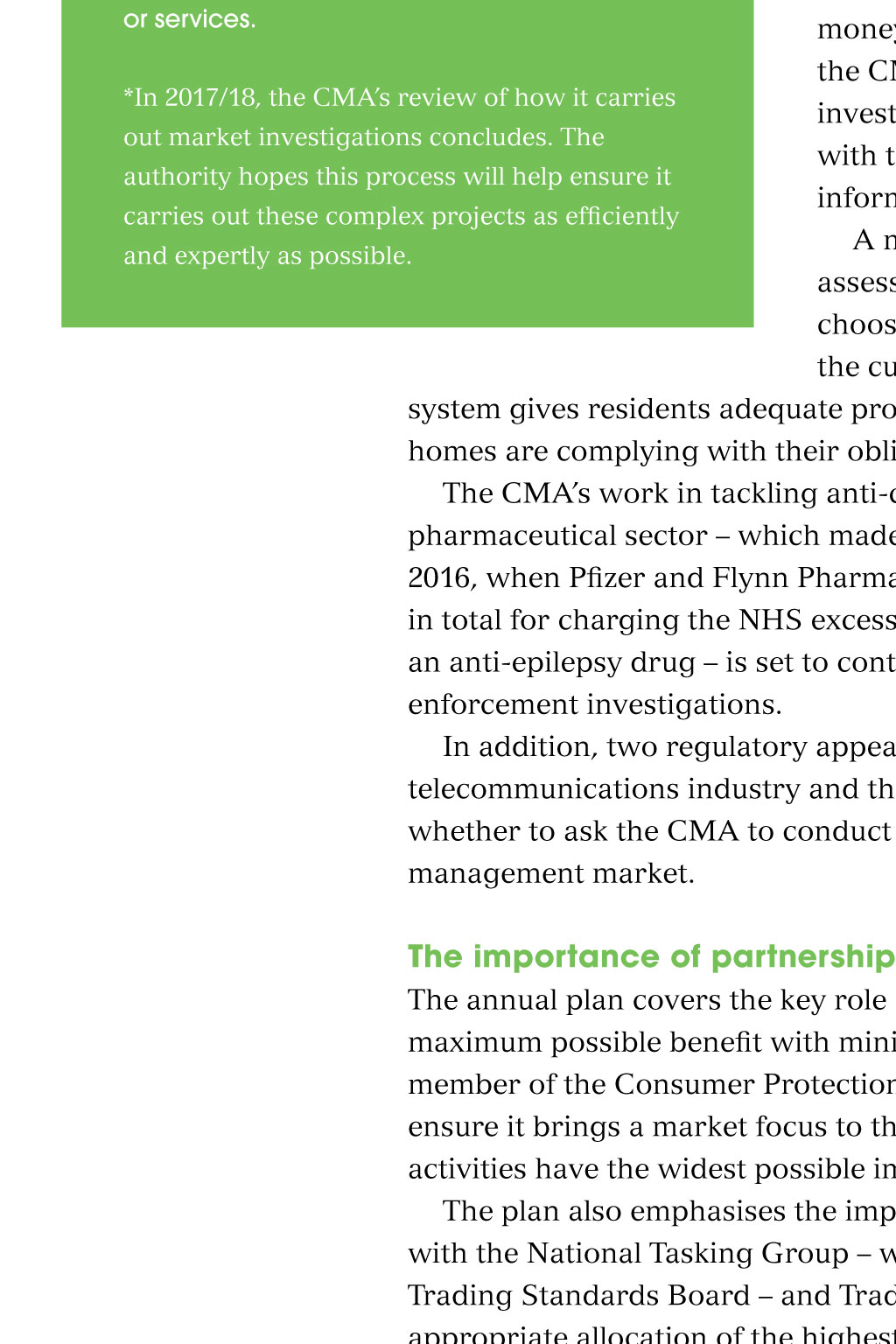
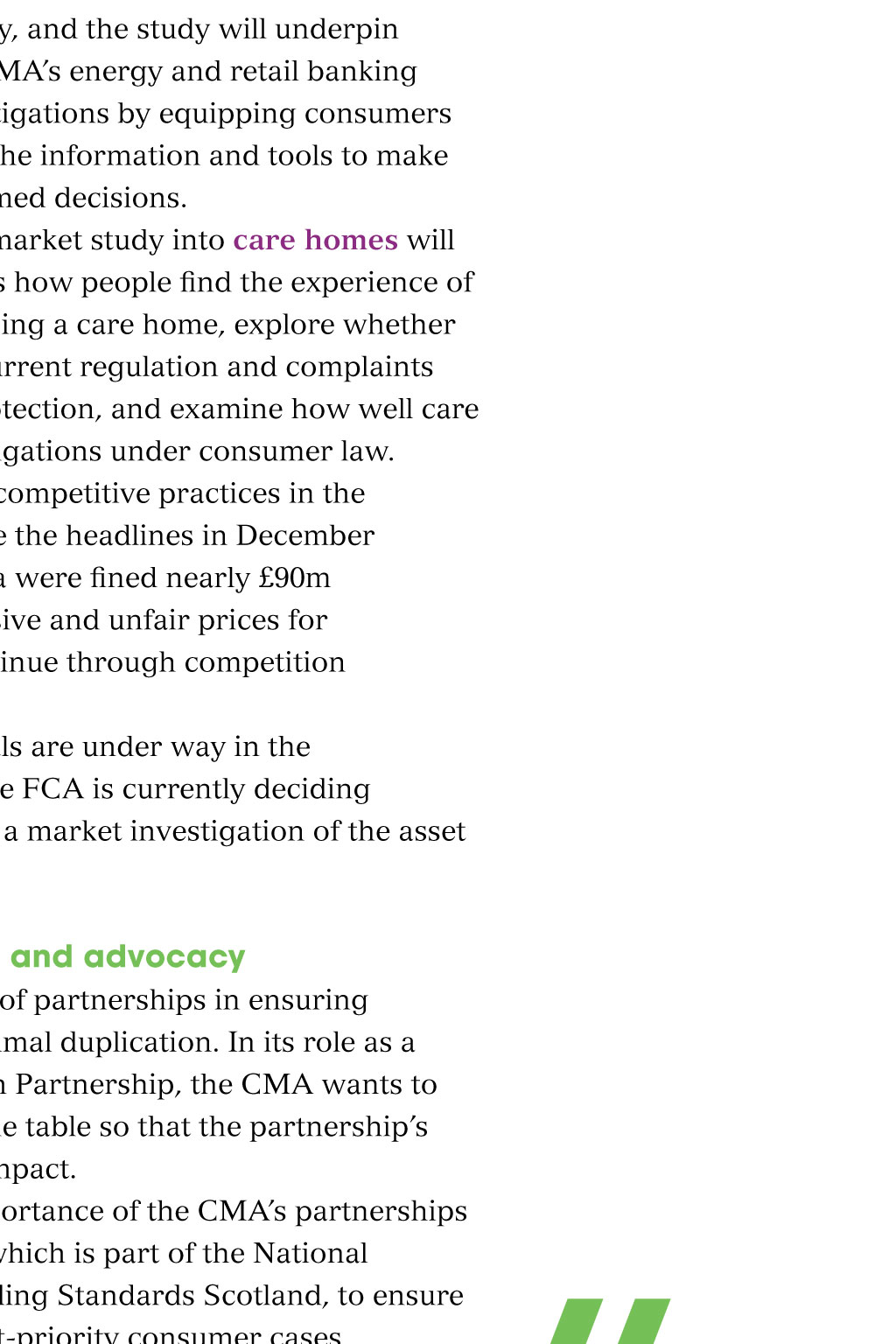
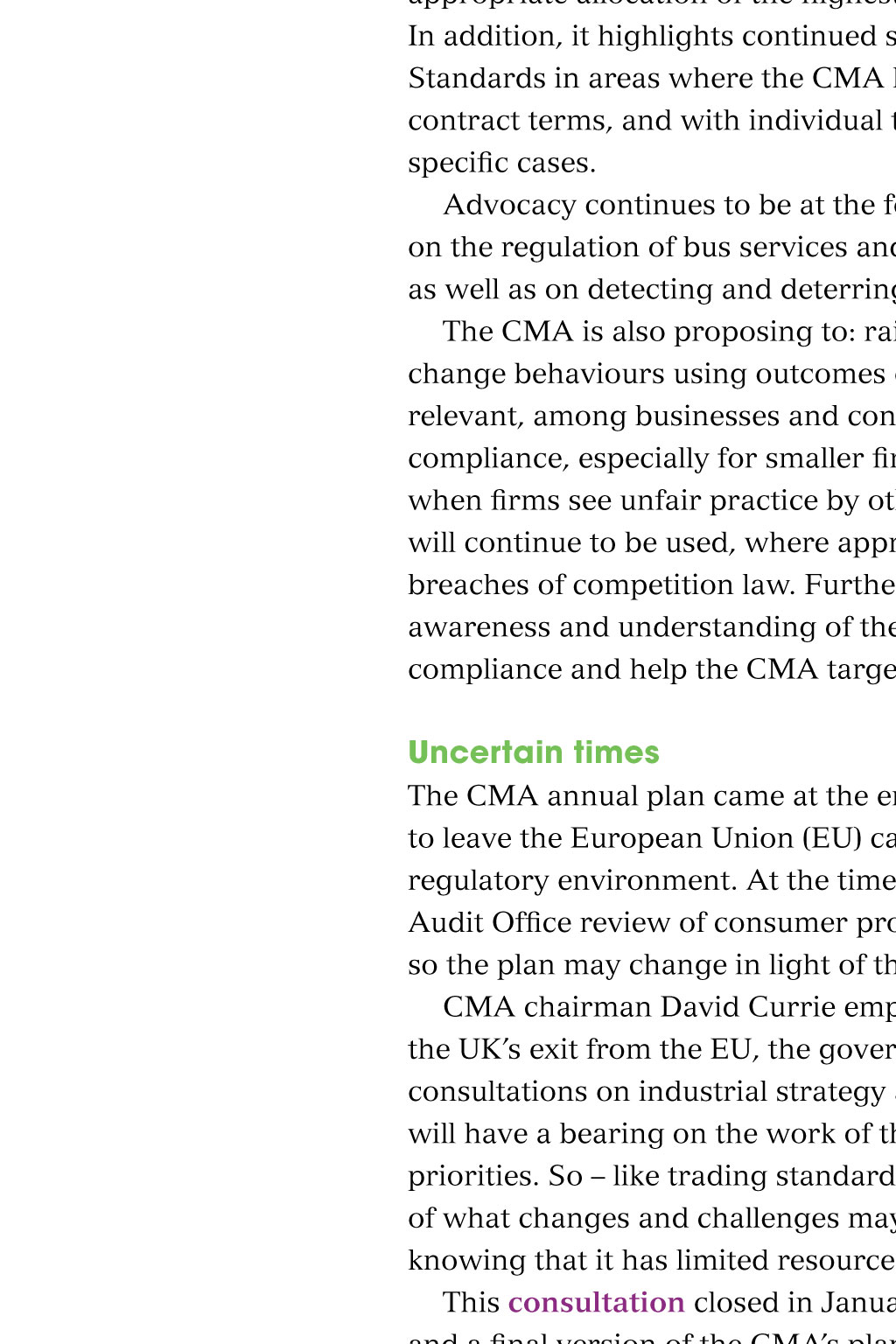
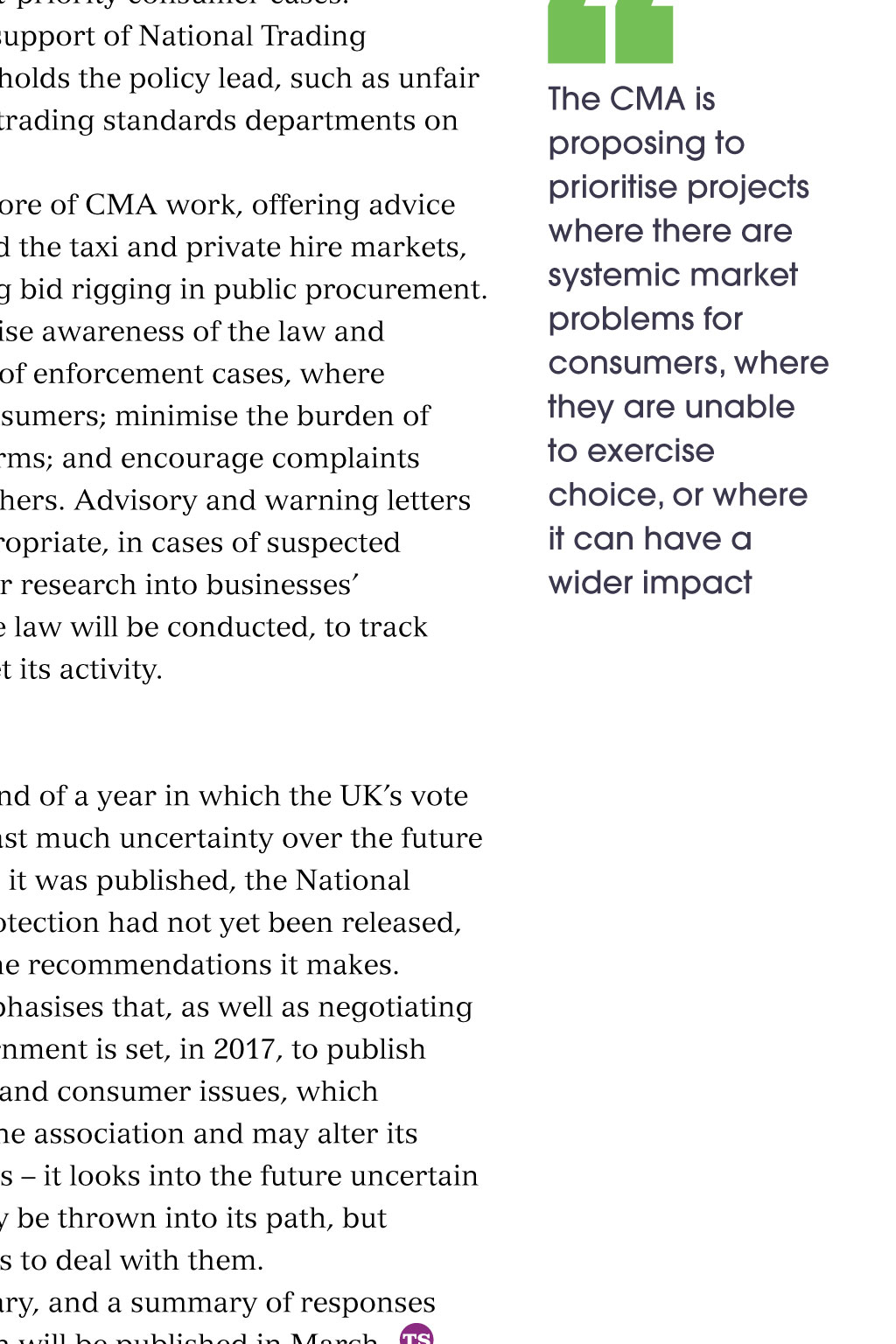
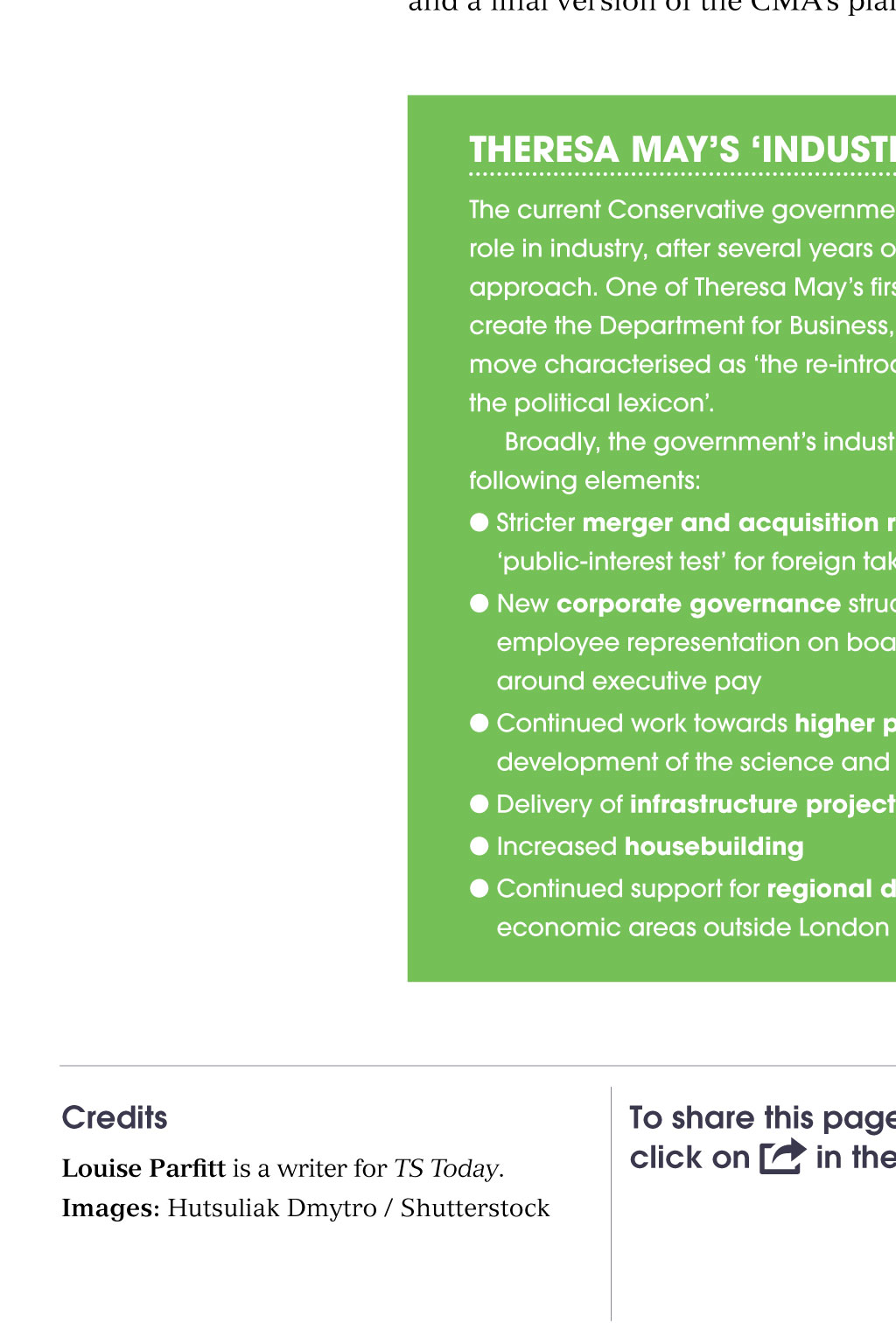
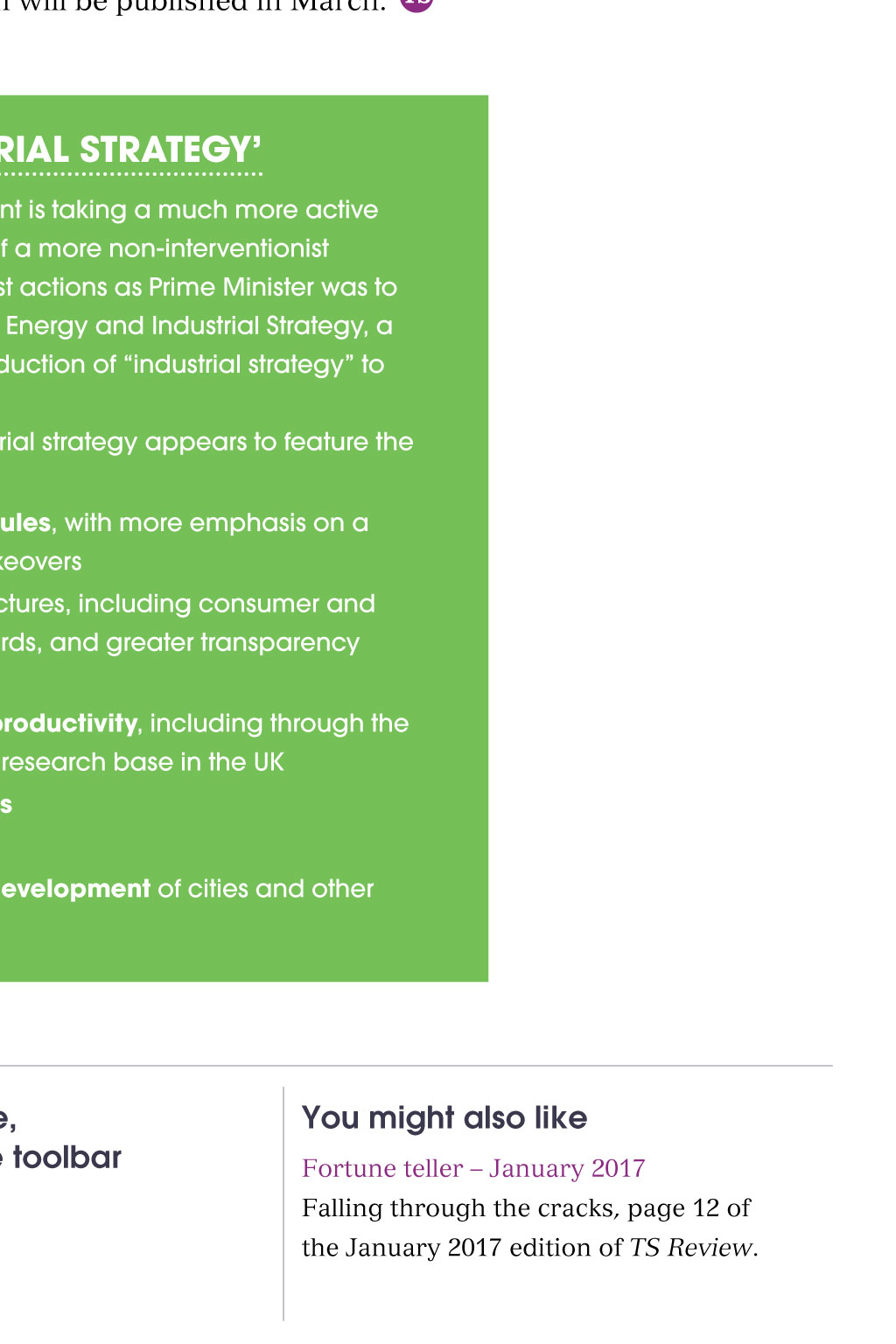

















Competition and Markets Authority: annual plan 2017/18 In this feature l enforcement l partnerships l advocacy Strategic moves The Competition and Markets Authority published its 2017/18 annual plan consultation in December. Louise Parfitt takes a look at some of the most salient points for trading standards T The CMA wants to launch as many new consumer cases or projects as possible, with four as a minimum here is a theme in the Competition and Markets Authority (CMA) draft annual plan for 2017/18 of doing things quicker in order to do more. One key development, with which many trading standards professionals will identify, isthe proposal to look at achieving results with leaner project teams and lower resource costs, while ensuring the CMA retains legal and economic rigour. When the plan was published in December 2016, the CMA had 16 civil competition enforcement cases on its books, five consumer enforcement cases, 16 merger investigations, two regulatory appeals and three market studies. In 2017/18, it wants to see these through to conclusion by agreement or litigation where appropriate and open fresh cases as resources become available. New criminal investigations and prosecutions will be pursued where appropriate, and businesses awareness and understanding of the law will be researched. There is a commitment to increasing the speed and volume of CMA casework. The authority wants to decrease the time it spends on competition enforcement investigations and increase the number of new cases by 50 per cent, up to a minimum of six in 2017/18. Consumer enforcement cases are to be concluded within 18 months and as many new consumer cases or projects as possible will be launched where there is requisite evidence, with four as a minimum while new criminal investigations will be opened as appropriate. Choice and fairness Ensuring people get a fair deal when buying goods and services remains central to the CMAs work, and it intends to increase the pace, scale and impact of its enforcement against anti-competitive or unfair practices. It will prioritise projects where there are systemic market problems for consumers, where they are unable to exercise choice, or where the CMA can have a wider impact for example, by developing the law or having a deterrent effect. Investigations carried out last year into the energy and retail banking sectors will start to have an impact on households and businesses. By April 2017, the CMA wants to have implemented the remedies resulting from these studies, including allowing energy suppliers to contact by letter rivals customers who have been on a default tariff for more than three years, to offer them cheaper deals, andhaving a maximum monthly charge for personal current accounts. It will continue to work with the Financial Conduct Authority (FCA) andOfgem to monitor the results, once these have been put in place. The package of measures proposed as a result of the legal services investigation, which concluded in December 2016, will also start to take effect, giving consumers better information about legal services to help them shop around more effectively. As online and digital transactions grow, the CMA proposes running a campaign to ensure online sellers knowhow to comply with UK StUDIES ExpLaINED competition law, while continuing Market studies are examinations into why withits ongoing competition particular markets may not be working well. enforcement investigation into alleged Market investigations* are more detailed online sales bans. The treatment of examinations into whether or not there is an consumers using online gambling firms adverse effect on competition in the market(s) is also being investigated. of products or services referred. They have In 2017/18, the CMA will carry out a more formal powers than studies, which can market study into digital comparison only make recommendations. tools (DCTs), which range from Market investigation references (MIRs) are price comparison websites (PCWs) usually made to the CMA by other bodies to smartphone apps. It will consider when there are reasonable grounds for suspecting that a feature or features of how to maximise the potential benefits a market prevent it from offering consumers for consumers, while addressing sufficient competitive choice in goods concernsabout how DCTs earn or services. money, and the study will underpin the CMAsenergy and retail banking *In 2017/18, the CMAs review of how it carries investigations by equipping consumers out market investigations concludes. The with the information and tools to make authority hopes this process will help ensure it informed decisions. carries out these complex projects as efficiently A market study into care homes will and expertly as possible. assess how people find the experience of choosing a care home, explore whether the current regulation and complaints system gives residents adequate protection, and examine how well care homes are complying with their obligations under consumer law. The CMAs work in tackling anti-competitive practices in the pharmaceutical sector which made the headlines in December 2016, when Pfizer and Flynn Pharma were fined nearly 90m in totalfor charging the NHS excessive and unfair prices for an anti-epilepsy drug is set to continue through competition enforcementinvestigations. In addition, two regulatory appeals are under way in the telecommunications industry and the FCA is currently deciding whether to ask the CMA to conduct a market investigation of the asset management market. the importance of partnership and advocacy The annual plan covers the key role of partnerships in ensuring maximum possible benefit with minimal duplication. In its role as a member of theConsumer Protection Partnership, the CMA wants to ensure it brings a market focus to the table so that the partnerships activities have the widest possible impact. The plan also emphasises the importance of the CMAs partnerships with the National Tasking Group which is part of the National Trading Standards Board and Trading Standards Scotland, to ensure appropriate allocation of the highest-priority consumer cases. In addition, it highlights continued support of National Trading Standards in areas where the CMA holds the policy lead, such as unfair contract terms, and with individual trading standards departments on specific cases. Advocacy continues to be at the fore of CMA work, offering advice on the regulation of bus services and the taxi and private hire markets, as well as on detecting and deterring bid rigging in public procurement. The CMA is also proposing to: raise awareness of the law and change behaviours using outcomes of enforcement cases, where relevant, among businesses and consumers; minimise the burden of compliance, especially for smaller firms; and encourage complaints when firms see unfair practice by others. Advisory and warning letters will continue to be used, where appropriate, in cases of suspected breaches of competition law. Further research into businesses awareness and understanding of the law will be conducted, to track compliance and help the CMA target its activity. The CMA is proposing to prioritise projects where there are systemic market problems for consumers, where they are unable to exercise choice, or where it can have a wider impact Uncertain times The CMA annual plan came at the end of a year in which the UKs vote to leave the European Union (EU) cast much uncertainty over the future regulatory environment. At the time it was published, the National Audit Office review of consumer protection had not yet been released, so the plan may change in light of the recommendations it makes. CMA chairman David Currie emphasises that, as well as negotiating the UKs exit from the EU, the government is set, in 2017, to publish consultations on industrial strategy and consumer issues, which will have a bearing on the work of the association and may alter its priorities. So like trading standards it looks into the future uncertain of what changes and challenges may be thrown into its path, but knowing that it has limited resources to deal with them. This consultation closed in January, and a summary of responses and a final version of the CMAs plan will be published in March. tHErESa MaYS INDUStrIaL StratEgY The current Conservative government is taking a much more active role in industry, after several years of a more non-interventionist approach. One of Theresa Mays first actions as Prime Minister was to create the Department for Business, Energy and Industrial Strategy, a move characterised as the re-introduction of industrial strategy to the political lexicon. Broadly, the governments industrial strategy appears to feature the following elements: Stricter merger and acquisition rules, with more emphasis on a public-interest test for foreign takeovers New corporate governance structures, including consumer and employee representation on boards, and greater transparency around executive pay Continued work towards higher productivity, including through the development of the science and research base in the UK Delivery of infrastructure projects Increased housebuilding Continued support for regional development of cities and other economic areas outside London Credits Louise Parfitt is a writer for TS Today. Images: Hutsuliak Dmytro / Shutterstock To share this page, in the toolbar click on You might also like Fortune teller January 2017 Falling through the cracks, page 12 of the January 2017 edition of TS Review.